Media and tray
This chapter provides information on how to load originals and print media into your machine.
This chapter includes:
You can use the scanner glass or the duplex automatic document feeder (DADF) to load an original for copying, scanning, and sending a fax.
Make sure that no originals are in the DADF. If an original is detected in the DADF, the machine gives it priority over the original on the scanner glass. To get the best scan quality, especially for colored or gray-scaled images, use the scanner glass.
Preparing originals
-
Do not load paper smaller than 25 x 25 (1.0 x 1.0 inches) or larger than 297 x 432 mm (11.7 x 17 inches).
-
Make sure any glue, ink, or correction fluid on the paper is completely dry before loading.
-
Open the DADF.
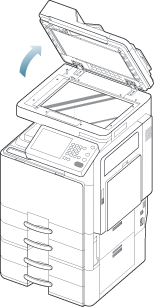
-
Place the original face down on the scanner glass and align it with the registration guide at the top left corner of the glass.
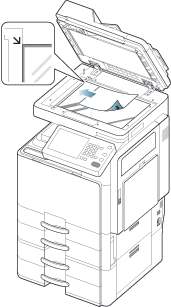
-
Close the DADF.
![[Note]](../common/note.png)
-
Leaving the DADF open while copying may affect copy quality and toner consumption.
-
Dust on the scanner glass may cause black spots on the printout. Always keep it clean.
-
If you are copying a page from a book or magazine, lift the DADF until its hinges are caught by the stopper and then close the lid. If the book or magazine is thicker than 30 mm (1 inch), start copying with the lid open.
![[Caution]](../common/caution.png)
-
Be careful not to break the scanner glass. You may get hurt.
-
Do not put hands on the scanner glass while closing the DADF. The DADF may fall on your hands and cause injury.
-
Do not look at the light inside of the scanner while copying or scanning. It is harmful to eyes.
-
Preparing originals
-
Do not load paper smaller than 140 x 140 mm (5.5 x 5.5 inches) or larger than 297 x 432 mm (11.7 x 17 inches).
-
The DADF can automatically detects Statement LEF, Statement SEF, JIS B5 LEF, JIS B5 SEF, A5 LEF, A5 SEF, A4 LEF, A4 SEF, Letter LEF, Letter SEF, B4, Ledger, Legal, and A3-sized originals.
-
Do not attempt to load the following types of paper, in order to prevent paper jam, low print quality, and machine damage.
-
Carbon-paper or carbon-backed paper
-
Coated paper
-
Onion skin or thin paper
-
Wrinkled or creased paper
-
Curled or rolled paper
-
Torn paper
-
-
Remove all staples and paper clips before loading.
-
Make sure any glue, ink, or correction fluid on the paper is completely dry before loading.
-
Do not load originals that include different sizes or weights of paper.
-
Do not load booklets, pamphlets, transparencies, or documents with other unusual characteristics.
Using the DADF, you can load up to 100 sheets of paper (80 g/m2, 20 lb bond) for one job.
-
Flex or fan the edge of the paper stack to separate the pages before loading originals.

-
Load the originals face up into the DADF. Make sure that the bottom of the original stack matches the paper size marked on the document input tray.
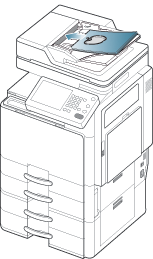
-
Adjust the document width guides to the paper size.
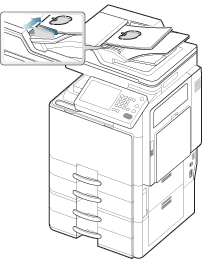
![[Note]](../common/note.png)
Dust on the DADF glass may cause black lines on the printout. Always keep the glass clean.
Selecting print media
You can print on a variety of print media, such as plain paper, envelopes, labels, and transparencies. Always use print media that meet the guidelines for use with your machine.
Print media that does not meet the guidelines outlined in this user’s guide may cause the following problems:
-
Poor print quality
-
Increased paper jams
-
Premature wear on the machine.
Properties, such as weight, composition, grain, and moisture content, are important factors that affect the machine’s performance and the output quality. When you choose print materials, consider the following:
-
The type, size, and weight of the print media for your machine are described in print media specifications (see Print media specifications ).
-
Desired outcome: The print media you choose should be appropriate for your project.
-
Brightness: Some print media are whiter than others and produce sharper, more vibrant images.
-
Surface smoothness: The smoothness of the print media affects how crisp the printing looks on the paper.
![[Note]](../common/note.png)
|
|
|
![[Caution]](../common/caution.png)
|
|
|
![[Warning]](../common/warning.png)
|
|
|
The use of inflammable media or foreign materials left in the printer may lead to overheating of the unit and, in rare cases may cause a fire. |
The amount of paper put into the tray may differ according to media type used (see Print media specifications ).
Loading paper in the tray
Load the print media you use for the majority of your print jobs into the standard tray. The standard tray can hold a maximum of 1,040 sheets of plain paper.
You can purchase an optional dual cassette feeder and attach it below the standard tray to load an additional 1,040 sheets of plain paper. Refer to the Supplies and Accessories guide in the supplied CD.
![[Note]](../common/note.png)
|
|
|
![[Caution]](../common/caution.png)
|
|
|
Using photographic paper or coated paper may cause problems, that require repairs. Such repairs are not covered by the warranty or service agreements. |
-
Squeeze the lock lever on the handle and pull out the tray.
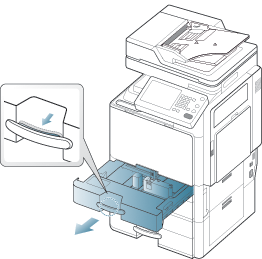
-
Squeeze the paper length guide, and pull it to the end of the tray.
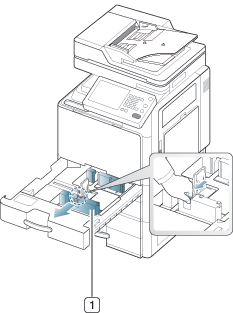
-
Paper length guide
-
-
Squeeze the paper width guide, and pull it to the end of the tray.
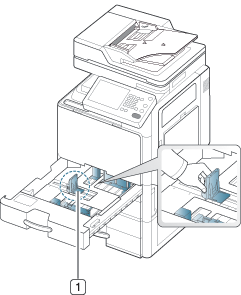
-
Paper width guide
-
-
Flex and fan the edge of the paper stack to separate the pages before loading papers.

-
Load paper with the print side facing up.
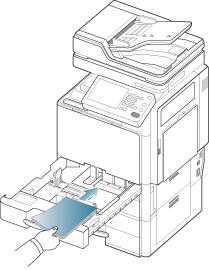
-
Adjust the paper length guide to the desired paper length.
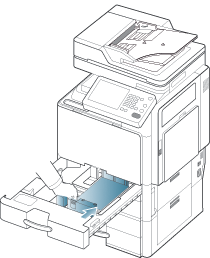
-
After loading paper into the tray, pinch the paper width guide and move it toward the stack of paper until it lightly touches the side of the stack. Do not press the guide too tightly to the edge of the paper, the guide may bend the paper.
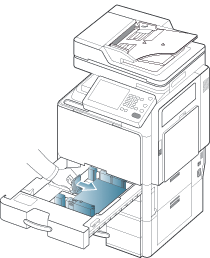
![[Note]](../common/note.png)
-
Do not push the paper guide too far causing the media to wrap.
-
If you do not adjust the paper width guide, it may cause paper jams.

![[Note]](../common/note.png)
Do not overload the tray. Otherwise, it may cause paper jams. Make sure that the paper is below the maximum paper capacity guide inside the tray.
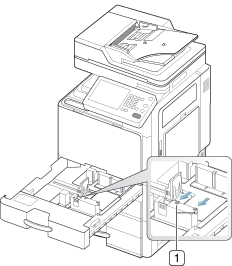
-
Paper capacity guide
-
-
Fix the the paper length guide using the locking switch. Release the locking switch to load a different sized paper.
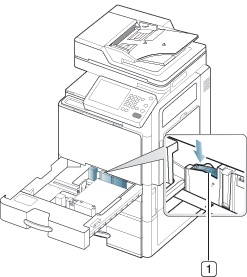
-
Locking switch
-
-
Insert the tray back into the machine.
When you print a document, set the paper type and size for the tray.
For information about setting the paper type and size on the control panel (See Tray setting).
The standard tray and optional dual cassette feeder can automatically detect various-sized paper (See Media sizes automatically detected).
If you set the in , the confirmation window appears automatically (See Setting the tray confirmation message).
Check if the paper size and type in the tray are detected or not. If you want to set the paper size and type or if the machine cannot detect them, you can set the size and type directly in the confirmation window.
![[Note]](../common/note.png)
Some paper types are displayed with abbreviation. stands for Tabloid Extra, and are Executive and Statement each.
![[Note]](../common/note.png)
-
If you experience problems with paper feeding, check whether the paper meets the media specification (See Print media specifications ). Then, try placing one sheet at a time in the multi-purpose tray (See Multi-purpose tray).
-
The settings made from the machine driver override the settings on the control panel.
To print from an application:
-
Open an application and start the print menu.
-
Open (See Opening printing preferences).
-
Press the tab in , and select an appropriate paper type, size, and source.
-
Press .
-
Start printing from an application.
-
-
You can increase the paper handling capacity of your machine by installing an optional high capacity feeder. This tray holds up to 2,000 sheets of paper.
![[Note]](../common/note.png)
|
|
|
The high capacity feeder can only hold A4 or letter-sized paper. |
![[Caution]](../common/caution.png)
|
|
|
Using photographic paper or coated paper may cause problems, that require repairs. Such repairs are not covered by the warranty or service agreements. |
-
Squeeze the lock lever on the handle and pull out the tray.
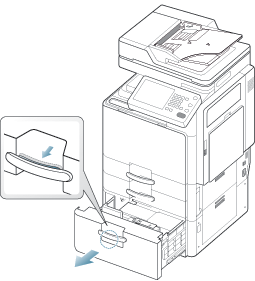
-
Flex and fan the edge of the paper stack to separate the pages before loading papers.

-
Load paper with the print side facing up.
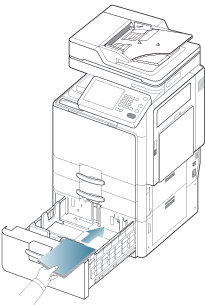
![[Note]](../common/note.png)
Align the paper and gently push it to the right side of the tray. Otherwise, it could cause paper jams.

-
Load the paper in the left side of the tray with the print side facing up. The left side of the tray can hold up to 1,000 sheets of plain paper.
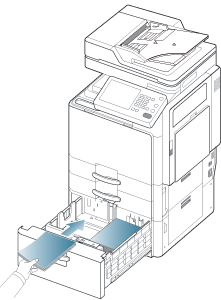
![[Note]](../common/note.png)
-
Do not overload the tray. Otherwise, it may cause paper jams. Make sure that the paper is below the maximum paper capacity guide inside the tray.
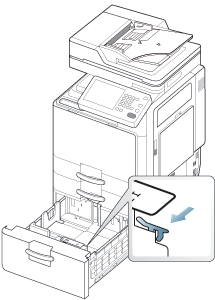
-
If the paper in the right side has run out, the guide automatically pushes the paper in the left side to right side automatically.
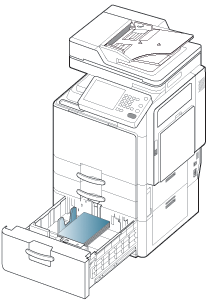
-
-
Insert the tray back into the high capacity feeder.
When you print a document, set the paper type and size for the tray.
For information about setting the paper type and size on the control panel (see Tray setting).
The multi-purpose tray can hold special sizes and types of print material, such as postcards, note cards, and envelopes. It is useful for single page printing on colored paper.
-
Load only one type, size, and weight of print media at a time in the multi-purpose tray.
-
To prevent paper jams, do not add paper while printing when there is still paper in the multi-purpose tray. This also applies to other types of print media.
-
Print media should be loaded face down with the top edge going into the multi-purpose tray first and be placed in the center of the tray.
-
Always load only the specified print media to avoid paper jams and print quality problems (see Print media specifications ).
-
Flatten any curl on postcards, envelopes, and labels before loading them into the multi-purpose tray.
-
Open the multi-purpose tray and pull out the extention if necessary.
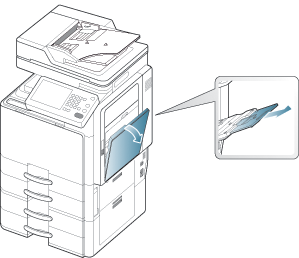
-
Flex or fan the edge of the paper stack to separate the pages before loading originals.

-
Load the paper with the side to be printed on facing down.
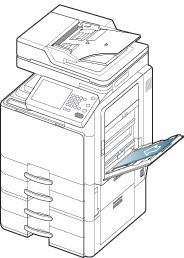
-
Squeeze the multi-purpose tray paper width guides and adjust them to the width of the paper. Do not force too much, otherwise the paper will bend resulting in a paper jam or skew.
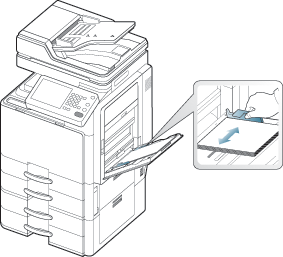
-
When you print a document, set the paper type and size for the multi-purpose tray.
The multi-purpose tray can automatically detect various-sized paper (see Media sizes automatically detected).
For information about setting the paper type and size on the control panel (see Tray setting).
![[Note]](../common/note.png)
The settings made from the machine driver override the settings on the control panel.
To print from an application:
-
Open an application, and start the print menu.
-
Open (see Opening printing preferences).
-
Press the tab in , and select an appropriate paper type, size, and source.
-
Press .
-
Start printing from an application.
-
Media sizes automatically detected
This machine can automatically detect various sized-paper. Refer to the table below.
|
size[a] |
Standard tray/ optional dual cassette feeder |
Multi-purpose tray |
Optional high capacity feeder |
Duplex printing |
|---|---|---|---|---|
|
Letter SEF[b] |
● |
o |
N/A |
Available |
|
Letter LEF[c] |
● |
● |
● |
Available |
|
Ledger |
● |
● |
N/A |
Available |
|
Legal |
● |
o |
N/A |
Available |
|
Executive SEF |
o |
o |
N/A |
Available |
|
Executive LEF |
N/A |
o |
N/A |
Available |
|
Statement SEF |
● |
● |
N/A |
Available |
|
Statement LEF |
N/A |
N/A |
N/A |
N/A |
|
A3 |
● |
● |
N/A |
Available |
|
A4 SEF |
● |
● |
N/A |
Available |
|
A4 LEF |
● |
● |
● |
Available |
|
A5 SEF |
● |
o |
N/A |
Available |
|
A5 LEF |
N/A |
● |
N/A |
N/A |
|
B4 |
● |
● |
N/A |
Available |
|
JIS B5 SEF |
● |
● |
N/A |
Available |
|
JIS B5 LEF |
N/A |
● |
N/A |
Available |
|
A6 SEF |
N/A |
● |
N/A |
N/A |
|
A6 LEF |
N/A |
N/A |
N/A |
N/A |
|
ISO B5 SEF |
o |
o |
N/A |
Available |
|
ISO B5 LEF |
N/A |
o |
N/A |
N/A |
|
Folio |
● |
o |
N/A |
Available |
|
Oficio |
o |
o |
N/A |
Available |
|
Tabloid Extra |
● |
o |
N/A |
Available |
|
SRA3 |
N/A |
o |
N/A |
N/A |
|
8K |
o |
o |
N/A |
Available |
|
16K |
o |
o |
N/A |
Available |
|
[a] This machine could detect the similar sized paper as the auto detected paper depending on the size. [b] SEF meaning is Short Edge Feed. [c] LEF meaning is Long Edge Feed. |
||||
(●: Detected, o: Not detected, N/A: You cannot load the paper in the tray.)
The table below shows the available special media for each tray.
![[Note]](../common/note.png)
|
|
|
When using special media, we recommend you feed a piece of paper at a time. Check the maximum input number of media for each tray (see Print media specifications ). |
|
Types |
Standard tray/ optional dual cassette feeder |
Optional high capacity feeder[a] |
Multi-purpose tray |
|---|---|---|---|
|
|
O |
O |
O |
|
|
O |
O |
O |
|
|
O |
O |
O |
|
|
X |
X |
O |
|
|
O |
O |
O |
|
|
O |
O |
O |
|
|
O |
O |
O |
|
|
O |
O |
O |
|
|
O |
O |
O |
|
|
O |
O |
O |
|
|
O |
X |
O |
|
|
O |
X |
O |
|
|
O |
O |
O |
|
|
O |
O |
O |
|
|
O |
X |
O |
|
|
X |
X |
O |
|
|
X |
X |
O |
|
|
X |
X |
O |
|
|
X |
X |
O |
|
|
O |
X |
O |
|
[a] Optional high capacity feeder supports only A4 and Letter sized paper. |
|||
The media types are shown in the . This paper type option allows you to set the type of paper to be loaded in the tray. This setting appears in the list so that you can select it. This will let you get the best quality printout. If not, the desired print quality may not be achieved.
-
: 71 to 90 g/m2 (19 to 24 lb) normal plain paper.
-
Thick: 91 to 105 g/m2 (25 to 28 lb) thick paper.
-
Heavy Weight: 106 to 175 g/m2 (29 to 46 lb) thick paper.
-
Extra Heavy Weight 1: 176 to 216 g/m2 (47 to 57 lb) thick paper.
-
Extra Heavy Weight 2: 217 to 253 g/m2 (58 to 67 lb) thick paper.
-
Thin: 60 to 70 g/m2 (16 to 18 lb) thin paper.
-
: 105 to 120 g/m2 (28 to 32 lb) bond.
-
: 75 to 90 g/m2 (20 to 24 lb) color-backgrounded paper.
-
: 120 to 150 g/m2 (32 to 40 lb) label.
-
: 138 to 146 g/m2 (37 to 39 lb) transparency paper.
-
: 75 to 90 g/m2 (20 to 24 lb) envelope.
-
: 75 to 90 g/m2 (20 to 24 lb) preprinted paper.
-
Cotton: 75 to 90 g/m2 (20 to 24 lb) cotton paper.
-
: 60 to 90 g/m2 (16 to 24 lb) recycled paper.
-
: 70 to 90 g/m2 (19 to 24 lb) If you need to keep the print-out for a long time, such as archives, select this option.
-
: 70 to 90 g/m2 (19 to 24 lb).
-
: 70 to 90 g/m2 (19 to 24 lb) .
-
: 105 to 163 g/m2 (28 to 43 lb) cardstock.
-
: 170 to 216 g/m2 (45 to 57 lb) cardstock.
-
: 106 to 169 g/m2 (28 to 45 lb) glossy paper.
-
: 170 to 253 g/m2 (45 to 67 lb) glossy paper.
Successful printing on envelopes depends upon the quality of the envelopes.
To print an envelope, place it with the flap side up.�
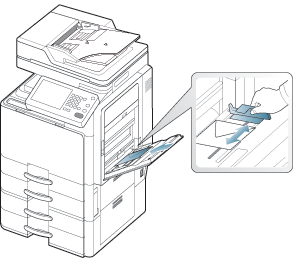
-
When selecting envelopes, consider the following factors:
-
Weight: The weight of the envelope paper should not exceed 90 g/m2 (16 lb) otherwise, a jam may occur.
-
Construction: Prior to printing, envelopes should lie flat with less than 6 mm (0.25 inches) curl, and should not contain air.
-
Condition: Envelopes should not be wrinkled, nicked, or damaged.
-
Temperature: Use envelopes that are compatible with the heat and pressure of the machine during operation.
-
-
Use only well-constructed envelopes with sharp-and well-creased folds.
-
Do not use stamped envelopes.
-
Do not use envelopes with clasps, snaps, windows, coated lining, self-adhesive seals, or other synthetic materials.
-
Do not use damaged or poorly made envelopes.
-
Be sure the seam at both ends of the envelope extends all the way to the corner of the envelope.

-
Acceptable
-
Unacceptable
-
-
Envelopes with a peel-off adhesive strip or with more than one flap that folds over to seal must use adhesives compatible with the machine’s fusing temperature about 170°C (338 °F) for 0.1 second. The extra flaps and strips might cause wrinkling, creasing, or jams, and may even damage the fuser.
-
For the best print quality, position margins no closer than 15 mm (0.6 inches) from the edges of the envelope.
-
Avoid printing over the area where the envelope’s seams meet.
To avoid damaging the machine, use only transparencies designed for use in laser printers.
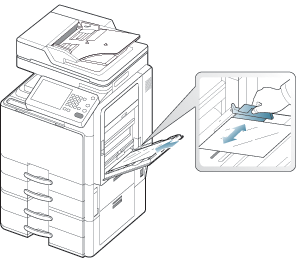
-
Transparencies used in the machine must be able to withstand the machine’s fusing temperature.
-
Place them on a flat surface after removing them from the machine.
-
Do not leave unused transparencies in the paper tray for long periods of time. Dust and dirt may accumulate on them, resulting in spotty printing.
-
To avoid smudging caused by fingerprints, handle them carefully.
-
To avoid fading, do not expose printed transparencies to prolonged sunlight.
-
Ensure that transparencies are not wrinkled, curled, or have any torn edges.
-
Do not use transparencies that separates from the backing sheet.
-
To prevent transparencies from sticking to each other, do not let the printed sheets stack up as they are begin printed out.
-
Recommended media: Transparency for a color laser printer by Xerox, such as 3R 91331(A4), 3R 2780(Letter).
Load the paper with the side to be printed on facing down.
To avoid damaging the machine, use only labels designed for use in laser machines.
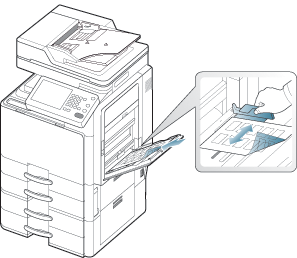
-
When selecting labels, consider the following factors:
-
Adhesives: The adhesive material should be stable at your machine’s fusing temperature about 170°C (338 °F) for 0.1 second.
-
Arrangement: Only use labels with no exposed backing between them. Labels can peel off sheets that have spaces between the labels, causing serious jams.
-
Curl: Prior to printing, labels must lie flat with no more than 13 mm (0.5 inches) of curl in any direction.
-
Condition: Do not use labels with wrinkles, bubbles, or other indications of separation.
-
-
Make sure that there is no exposed adhesive material between labels. Exposed areas can cause labels to peel off during printing, which can cause paper jams. Exposed adhesive can also cause damage to machine components.
-
Do not run a sheet of labels through the machine more than once. The adhesive backing is designed for only a single pass through the machine.
-
Do not use labels that are separating from the backing sheet or are wrinkled, bubbled, or damaged.
-
Do not load paper that does not have space between labels running the same direction as the paper is being fed. Otherwise, it could cause paper jams.
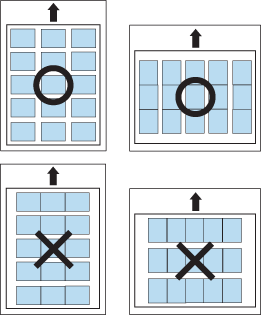
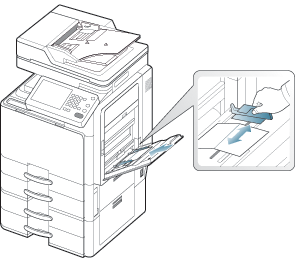
-
Do not print on media smaller than 98 mm (3.8 inches) wide or 148 mm (5.8 inches) long.
-
In the software application, set margins to at least 6.4 mm (0.25 inches) away from the edges of the material.
|
Single-sided |
double-sided |
|
|---|---|---|
|
Standard tray/ Optional dual cassette feeder |
Face up 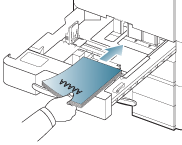
|
Face down 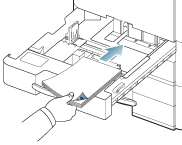
|
|
Multi-purpose tray |
Face down 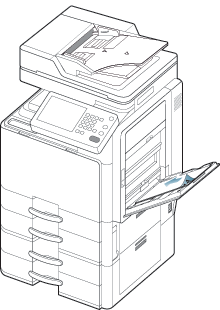
|
Face up 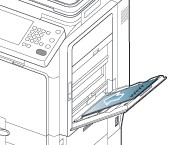
|
-
Preprinted paper must be printed with heat-resistant ink that will not melt, vaporize, or release hazardous emissions when subjected to the machine’s fusing temperature about 170°C (338 °F) for 0.1 second.
-
Preprinted paper ink must be non-flammable and should not adversely affect machine rollers.
-
Forms should be sealed in a moisture-proof wrapping to prevent changes during storage.
-
Before you load preprinted paper, verify that the ink on the paper is dry. During the fusing process, wet ink can come off preprinted paper, reducing print quality.
After loading paper in the paper tray, set the paper size and type using the display screen. For computer printing, select the paper size and type in the application program you use on your computer (see Opening printing preferences).
![[Note]](../common/note.png)
|
|
|
The settings made from the machine driver override the settings on the display screen. |
Setting the paper size
-
Press > > > select the tray you want from the display screen.
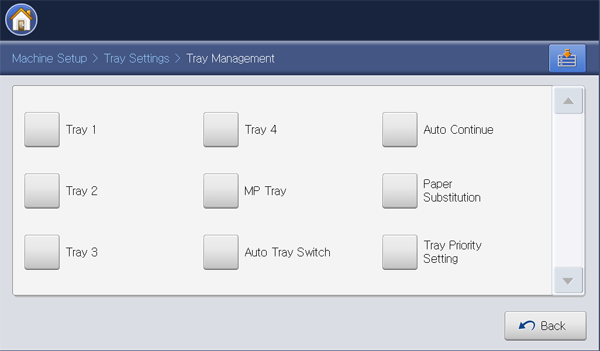
-
Press and select the paper size.
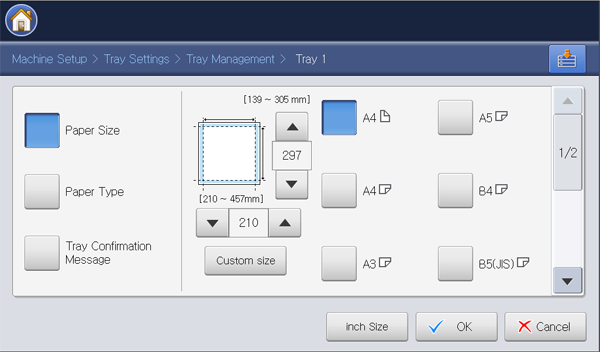
-
You can change the paper list on the display screen pressing or . The paper lists are divided into the available A/B type and letter type paper in this machine.
-
If there is no required size paper or you need to use custom sized paper, press the cardinal point arrows to set the paper size. You can also set and save the custom size using . You can select the custom size whenever you need it.
-
-
Press to save the selection.
Setting the paper type
-
Press > > > select the tray you want from the display screen.

-
Press and select the paper type.
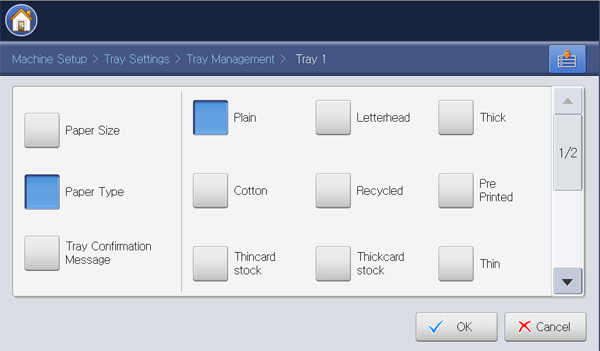
-
Press .
Auto tray switch
This is the option to set if the machine is to continue printing or not when any tray becomes empty. For example, both tray 1 and tray 2 are filled with the same size paper, the machine automatically prints from tray 2 after the tray 1 runs out of paper.
-
Press > > > .

-
Press .
-
Press .
Auto continue
This option allows you to continue printing when the paper size you have set is mismatched with the paper in the tray. When this option is activated, the machine continues printing using similar or large size paper. If this option is inactivated, the machine waits until the required size paper is loaded in the tray.
-
Press > > > .

-
Press .
-
Press .
Paper substitution
When the requested paper for a print job is not available in the tray, this feature allows you to substitute similar paper size, For example, if the requested ledger sized paper is not available in the tray, this machine substitutes A3 for the requested paper.
![[Note]](../common/note.png)
|
|
|
When the paper is substituted, some image loss may occur. |
-
Press > > > .

-
Press .
-
Press .
Tray priority setting
When you do not select the tray for printing, the tray selected as in the will be used in order. If the tray does not have the paper on which you want to print, the machine automatically prints from the trays in the priority order set.
-
Press > > > .

-
Press a tray, and give priority in the order for printing job using and .
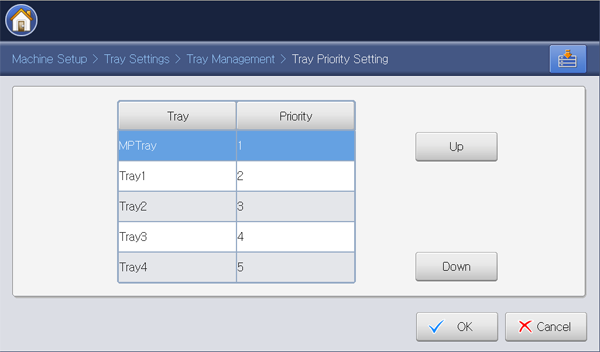
-
Press .
Setting the tray confirmation message
When you load paper into a tray, you can set the confirmation message to appear automatically. This machine can detect some paper sizes and types automatically. If you want to set the paper size and type, or the machine cannot detect them, you can set the size and type directly in the confirmation window.
-
Press > > > select the tray you want from the display screen.

-
Press .
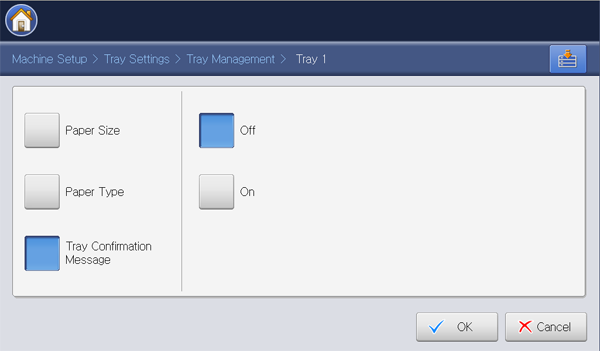
-
Press .
-
Press .